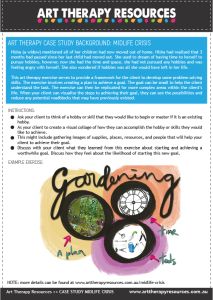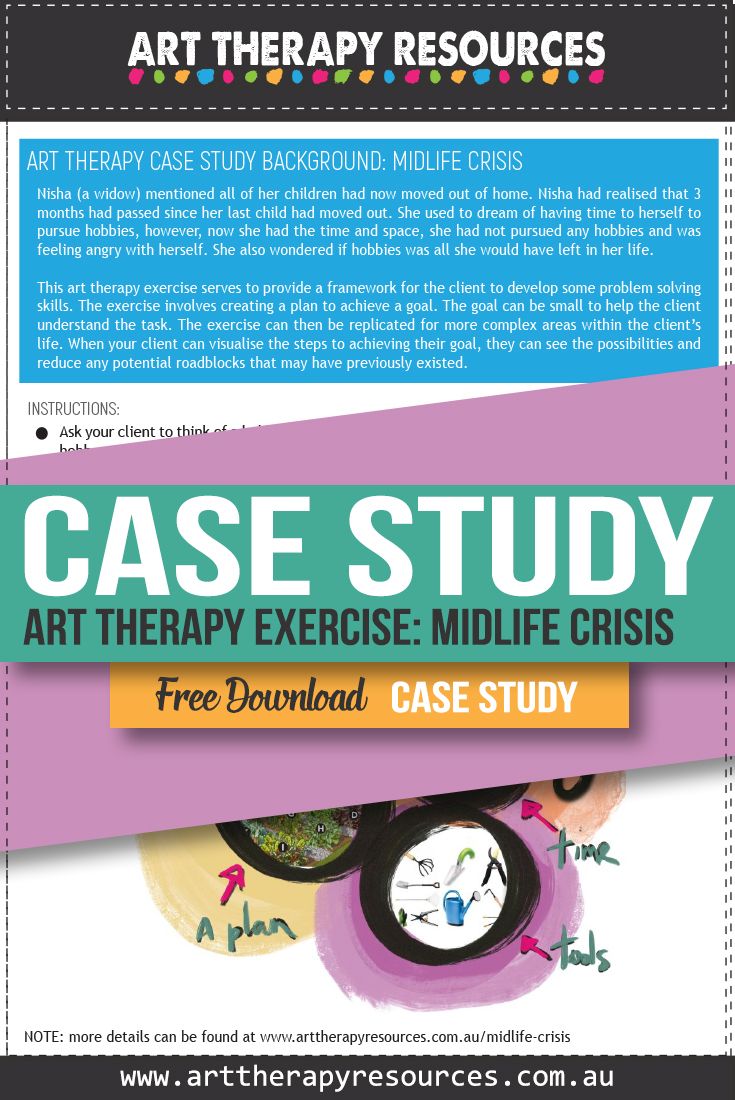THIS POST INCLUDES:
- Art Therapy and Midlife Crisis
- About the Client
- Art Therapy Exercise
- Client Insight and Outcomes
- Disclaimer
- FREE DOWNLOAD Art Therapy Exercise
ART THERAPY AND MIDLIFE CRISIS
A midlife crisis in many ways is the intersection of expectations, perception, and emotions. The expectations are what you may have previously thought your life would look like at this age. Your perception is based on what you do have vs what you wanted. Perception is also integral to the understanding that the years ahead in your life may have limits on both age and skills achieved. The primary emotions involved when assessing both the expectations and perceptions that you held can be based on anxiety and fear.
Midlife crisis as a term doesn’t appear in the DSM, and therefore many therapists may dismiss it as pop culture psychology. The universal experience that does exist for many people is the transition between various life stages of the lifespan. This is true of the transition between teenager and adult, and adult to elderly. At various stages in the lifespan, individuals can experience a crisis of identity and purpose. This experience can fall under the midlife crisis banner.
CHARACTERISTICS OF A MIDLIFE CRISIS
Below are some of the main characteristics that identify a midlife crisis. Many of these characteristics may be in opposition to each other. For example, a midlife crisis could initiate an intense motivation for change in one person, however, another person may experience a retreat from attempts to change:
- Relationship problems including infidelity
- Obsession with physical appearance
- Career dissatisfaction
- Emotional distress
- Dissatisfaction with favourite activities
- Feeling restless
- Seeking radical change and transformations
- Anxiety about the future
- Regret about previous life choices
- Confusion about self-identity and purpose
- Daydreaming
- Irritability
- Anger
- Sadness
- Increased use of alcohol, drugs, food, or other negative coping mechanisms
- Decreased or increased sexual desire
- Decreased or increased ambition
HOW ART THERAPY CAN HELP WITH A MIDLIFE CRISIS
Art therapy plays an important part in helping clients who are on a path of self-discovery. Below are some of the ways in which art therapy can help a client who is experiencing issues in midlife:
- Self-identity
- Anxiety
- Depression
- Exploring meaning and purpose
- Exploring goals and aspirations
- Reframing the definition of life success to be individualized
ABOUT THE CLIENT
- Name: Nisha
- Age: 44
CURRENT CLIENT ISSUES:
Nisha had been referred to an art therapist to explore her recent dissatisfaction with her life. Nisha was attending her first session. Nisha (a widow) mentioned all of her children had now moved out of home.
Nisha had realised that 3 months had passed since her last child had moved out. She used to dream of having time to herself to pursue hobbies, however, now she had the time and space, she had not pursued any hobbies and was feeling angry with herself. She also wondered if hobbies was all she would have left in her life.
ART THERAPY EXERCISE
The exercise can then be replicated for more complex areas within the client’s life. When your client can visualise the steps to achieving their goal, they can see the possibilities and reduce any potential roadblocks that may have previously existed.
INSTRUCTIONS:
- Ask your client to think of a hobby or skill that they would like to begin or master if it is an existing hobby.
- As your client to create a visual collage of how they can accomplish the hobby or skills they would like to achieve.
- This might include gathering images of supplies, places, resources, and people that will help your client to achieve their goal.
- Discuss with your client what they learned from this exercise about starting and achieving a worthwhile goal. Discuss how they feel about the likelihood of starting this new goal.
CLIENT INSIGHT AND OUTCOMES
After the exercise Nisha felt she had a clear plan to start something. Nisha also felt she had achieved something that had purpose by completing the exercise.
Nisha said she felt good that she had given herself some time to explore how she felt about her ability to accomplish things because she had been feeling worthless for doing nothing since her last child had left home.

DISCLAIMER
FREE DOWNLOAD: Art Therapy Exercise

BUILD YOUR ART THERAPY REFERENCE MATERIALS:
Pin this image to your Pinterest board.

SHARE KNOWLEDGE & PASS IT ON:
If you’ve enjoyed this post, please share it on Facebook, Twitter, Pinterest. Thank you!
